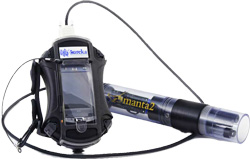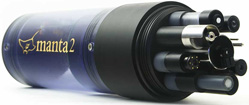 |
|
|
||||||||||||||||||||||
Dedicated Water Quality Data Loggers Every aspect of the Manta2 is designed for increased reliability and durability. The innovative Manta2 platform takes the intelligence of the instrument off of the main electronics package and moves it to the individual sensors. This allows for quick diagnostics if a sensor gets damaged, lowers the overall cost of the sonde, and allows for quick adaptation to new sensor technologies. Other features of the Manta2 include a single interface board that allows each sensor to communicate independently which lowers costs and simplifies troubleshooting time. Recessed sensors that are less likely to get damaged and require less calibration solution. A detachable cable lock system that minimizes pins and connector breakage, allowing cables to be easily exchanged while maintaining a sealed system with fewer components, again reducing maintenance and repair costs. The polyurethane cable assembly is substance-filled to prevent water from traveling in the event of a minor cut. And the clear plastic housing allows the user to see if the double O-ring seals have been breached, while LED's on the circuit board provide logging status, diagnostic and operational information. Eureka's free Manta2 Manager Windows-based software guides you through setup, calibration and data download processes while connected, and powered, by any PC USB port. The real-time graphing makes it easy for you to visually recognize when your readings have stabilized, and the calibration log provides a regulatory record of instrument calibration history. The Manta2 Manager software is designed so that the hand held Amphibian version “mirrors” the PC version - once you have learned one you will be familiar with both. Current available sensor parameters include:
Conductivity Sensor - The open flow design of the conductivity sensor prevents air bubbles from interfering with the reading and allows sediment to fall away from the sensor. Uniquely designed for easy maintenance with no cell blocks to remove or clean. Dissolved Oxygen Sensor (Polargraphic) - Changing DO membranes is easy with the snap-on caps which provide uniform stretching for more consistent results and eliminate bubbles and wrinkles. A built-in magnetic stirrer maintains consistent flow over the D/O sensor. Dissolved Oxygen Sensor (Optical) - Besides its reliable, field-proven design, Eureka’s new optical dissolved oxygen (ODO) sensor offers several advantages. Because the sensor consumes no oxygen, response is fast and no stirring is needed. The typical lifespan is more than five to ten years, during which time there are no consumable parts, caps, or membranes to replace. And because the sensor is more stable than membrane-covered sensors, calibration frequency is reduced. PH Sensor - With replaceable reference solution in the glass pH sensor, you can top off the reference solution without the need to replace the entire sensor. The sensor lasts for years and the glass pH bulb is easy to clean and difficult to break. Turbidity Sensor - The innovative design of the McVan Turbidity Sensor provides superior linearity; mathematical algorithms eliminate sand and similar particles from the turbidity calculations, and the built-in wiper keeps the lens clean. Optical Sensors - Chlorophyll a, Blue-Green Algae, Rhodamine - Self-cleaning optical sensors with integrated wipers remove biofouling and maintain high data accuracy and improved reliability during extended deployments. Ion Specific Sensors - Ammonium, Nitrate, Chloride, Sodium - An inexpensive and easy to replace sensor tip is all that is required when the sensor falls out of calibration. Depth & Stage Sensor - The non-vented digital depth sensor is ideal for profiling applications, while the vented digital stage pressure transducer is designed for long-term deployments. Specifications |
||||||||||||||||||||||
|
Copyright
© 2001 Geo Scientific Inc., All Rights Reserved |
||||||||||||||||||||||

